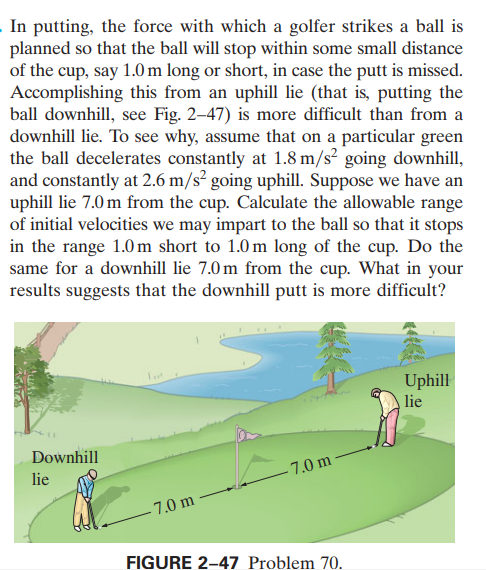In putting, the force with which a golfer strikes a ball is planned so that the ball will stop within some small distance of the cup, say 1.0m long or short, in case the putt is missed. Accomplishing this from an uphill lie (that is, putting the ball downhill, see Fig. 2–47) is more difficult than from a downhill lie. To see why, assume that on a particular green the ball decelerates constantly at 1.8 m/s² going downhill, and constantly at 2.6 m/s² going uphill. Suppose we have an uphill lie 7.0 m from the cup. Calculate the allowable range of initial velocities we may impart to the ball so that it stops in the range 1.0 m short to 1.0 m long of the cup. Do the same for a downhill lie 7.0 m from the cup. What in your results suggests that the downhill putt is more difficult? Uphill lie Downhill 7.0 m lie - 7.0 m FIGURE 2-47 Problem 70.
In putting, the force with which a golfer strikes a ball is planned so that the ball will stop within some small distance of the cup, say 1.0m long or short, in case the putt is missed. Accomplishing this from an uphill lie (that is, putting the ball downhill, see Fig. 2–47) is more difficult than from a downhill lie. To see why, assume that on a particular green the ball decelerates constantly at 1.8 m/s² going downhill, and constantly at 2.6 m/s² going uphill. Suppose we have an uphill lie 7.0 m from the cup. Calculate the allowable range of initial velocities we may impart to the ball so that it stops in the range 1.0 m short to 1.0 m long of the cup. Do the same for a downhill lie 7.0 m from the cup. What in your results suggests that the downhill putt is more difficult? Uphill lie Downhill 7.0 m lie - 7.0 m FIGURE 2-47 Problem 70.
Principles of Physics: A Calculus-Based Text
5th Edition
ISBN:9781133104261
Author:Raymond A. Serway, John W. Jewett
Publisher:Raymond A. Serway, John W. Jewett
Chapter2: Motion In One Dimension
Section: Chapter Questions
Problem 6CQ
Related questions
Question

Transcribed Image Text:In putting, the force with which a golfer strikes a ball is
planned so that the ball will stop within some small distance
of the cup, say 1.0m long or short, in case the putt is missed.
Accomplishing this from an uphill lie (that is, putting the
ball downhill, see Fig. 2–47) is more difficult than from a
downhill lie. To see why, assume that on a particular green
the ball decelerates constantly at 1.8 m/s² going downhill,
and constantly at 2.6 m/s² going uphill. Suppose we have an
uphill lie 7.0 m from the cup. Calculate the allowable range
of initial velocities we may impart to the ball so that it stops
in the range 1.0 m short to 1.0 m long of the cup. Do the
same for a downhill lie 7.0 m from the cup. What in your
results suggests that the downhill putt is more difficult?
Uphill
lie
Downhill
7.0 m
lie
- 7.0 m
FIGURE 2-47 Problem 70.
Expert Solution
This question has been solved!
Explore an expertly crafted, step-by-step solution for a thorough understanding of key concepts.
This is a popular solution!
Trending now
This is a popular solution!
Step by step
Solved in 2 steps with 5 images

Recommended textbooks for you

Principles of Physics: A Calculus-Based Text
Physics
ISBN:
9781133104261
Author:
Raymond A. Serway, John W. Jewett
Publisher:
Cengage Learning

University Physics Volume 1
Physics
ISBN:
9781938168277
Author:
William Moebs, Samuel J. Ling, Jeff Sanny
Publisher:
OpenStax - Rice University

Principles of Physics: A Calculus-Based Text
Physics
ISBN:
9781133104261
Author:
Raymond A. Serway, John W. Jewett
Publisher:
Cengage Learning

University Physics Volume 1
Physics
ISBN:
9781938168277
Author:
William Moebs, Samuel J. Ling, Jeff Sanny
Publisher:
OpenStax - Rice University